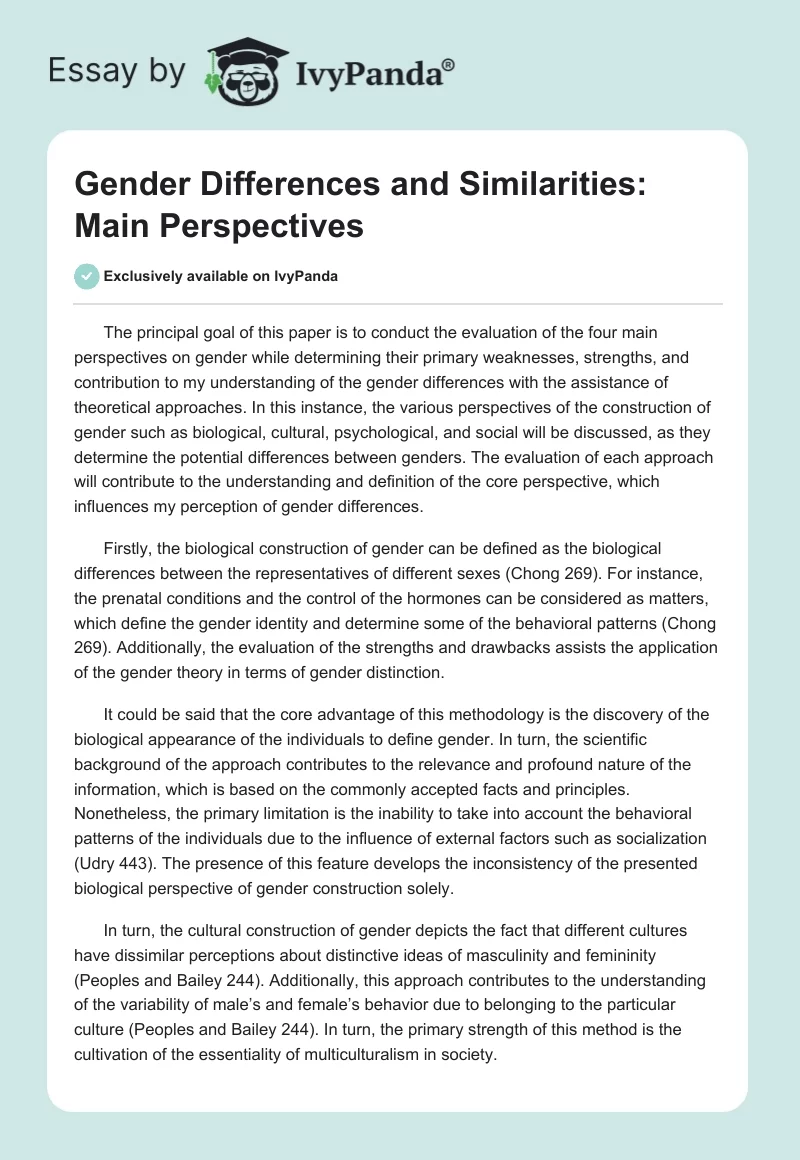The principal goal of this paper is to conduct the evaluation of the four main perspectives on gender while determining their primary weaknesses, strengths, and contribution to my understanding of the gender differences with the assistance of theoretical approaches. In this instance, the various perspectives of the construction of gender such as biological, cultural, psychological, and social will be discussed, as they determine the potential differences between genders. The evaluation of each approach will contribute to the understanding and definition of the core perspective, which influences my perception of gender differences.
Firstly, the biological construction of gender can be defined as the biological differences between the representatives of different sexes (Chong 269). For instance, the prenatal conditions and the control of the hormones can be considered as matters, which define the gender identity and determine some of the behavioral patterns (Chong 269). Additionally, the evaluation of the strengths and drawbacks assists the application of the gender theory in terms of gender distinction.
It could be said that the core advantage of this methodology is the discovery of the biological appearance of the individuals to define gender. In turn, the scientific background of the approach contributes to the relevance and profound nature of the information, which is based on the commonly accepted facts and principles. Nonetheless, the primary limitation is the inability to take into account the behavioral patterns of the individuals due to the influence of external factors such as socialization (Udry 443). The presence of this feature develops the inconsistency of the presented biological perspective of gender construction solely.
In turn, the cultural construction of gender depicts the fact that different cultures have dissimilar perceptions about distinctive ideas of masculinity and femininity (Peoples and Bailey 244). Additionally, this approach contributes to the understanding of the variability of male’s and female’s behavior due to belonging to the particular culture (Peoples and Bailey 244). In turn, the primary strength of this method is the cultivation of the essentiality of multiculturalism in society.
Additionally, this approach helps discover the role of gender from the dissimilar perspectives of different cultures and ethnic groups. Nonetheless, the primary drawback is the fact that the cultures might have opposing views about female and male roles. In this instance, the presence of this matter might be a primary cause of confusion while determining the differences between genders, as the commonly accepted behavior in one culture might be considered inappropriate in another one and vice versa.
As for the psychological gender construction, it defines gender as a mental condition of an individual with a high correlation to the interdependence between the well-being and social identity (Nastashi and Borja 93). In turn, belonging to a particular gender is dependent on individual attitudes and self-relation (Fine-Davies 56). It could be said that the primary benefit is the ability to take into account various approaches while defining the gender differences including biology and social perception of the gender. The ability to depict different aspects contributes to the overall understanding of the distinction of genders while acquiring the overall image of the process. Nonetheless, the primary drawback is the bias of the theory due to the extended variety of the methods in psychology and the necessity to take into account the individual attitudes about the topic.
Lastly, the primary features of the theory of the social construction of gender have to be emphasized. The framework implies the vitality of the interactions, socialization, and social expectations in defining the belonging to the particular sex (Evans 54). In turn, the social hierarchy and social norms also contribute to the establishment of the behavioral patterns and core attributes of the outlooks of the individuals (Evans 54). It could be said that the theory discovers gender differences while taking into account the core components of the complex mechanisms of society. The primary benefit is the discovery of the interdependence between the individuals while defining the gender, as they are highly engaged in interactions. Nonetheless, the critical drawback is the absence of the ability to depict the correlation of biological aspects, as they determine physical differences and initial behavioral patterns based on the hormones, the structure of the DNA, and other matters.
In the end, the evaluation of all theories, which are presented above, contributes to the ability to define gender differences. Nonetheless, it could be said that psychological perception assists in the understanding of the presence of the gender difference the most. The primary reason for the selection of this approach is its ability to consider the definers of the belonging to the particular gender from the dissimilar perspectives due to the plethora of psychological theories. In this instance, social, individual, and biological approaches are taken into account, as they are the major components of the theoretical basis of psychology. It could be said that it helps understand the gender differences the most, as the essential features are depicted from various perceptions.
Works Cited
Chong, Jing. “Biological and Social Construction of Gender Differences and Similarities: A Psychological Perspective.” The Review of Communication 5.4 (2005): 269-271. Print.
Evans, Mary. Gender and Social Theory, Buckingham: Open University Press, 2003. Print.
Fine-Davies, Margret. Gender Roles in Ireland: Three Decades of Attitude Change, London: Routledge, 2015. Print.
Nastashi, Bonnie, and Amanda Borja. International Handbook of Psychological Well-Being in Children and Adolescents, New York: Springer Science+Business Media, 2016. Print.
Peoples, James, and Garrik Bailey. Humanity: An Introduction to Cultural Anthropology, Stamford: South-Western Cengage Learning, 2015. Print.
Udry, Richard. “Biological Limits of Gender Construction.” American Sociological Review 65.3 (2000): 443-457. Print.


